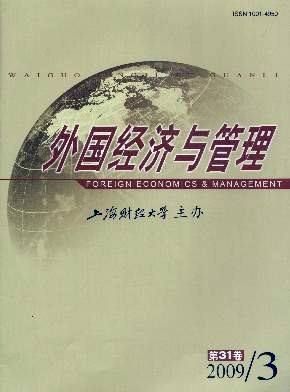探索性创新、开发性创新及其平衡研究前沿探析
外国经济与管理 2009 年 第 31 卷第 03 期, 页码:23 - 29
摘要
参考文献
摘要
基于探索和开发理论视角可把创新分为探索性和开发性两种。本文在考察探索性和开发性创新的内涵、相互关系、影响因素的基础上,探讨了这两种创新方式及其平衡对组织绩效的影响,最后指出了现有研究的不足,并对后续研究进行了展望。
[1]Teece,D J,Pisano,G,and Shuen,A.Dynamic capabilities and strategic management[J].Strategic Management Journal,1997,18(7):509-533.
[2]Benner,M J,and Tushman,M L.Exploitation,exploration,and process management:The productivity dilemma revisited[J].A-cademy of Management Review,2003,28(2):238-256.
[3]He,Z L,and Wong,P K.Exploration vs.exploitation:An empirical test of the ambidexterity hypothesis[J].Organization Science,2004,15(7/8):481-494.
[4]Leana,C,and Barry,B.Stability and change as simultaneous experiences in organizational life[J].Academy of Management Re-view,2000,25(4):753-759.
[5]March,J G.Exploration and exploitation in organizational learning[J].Organization Science,1991,2(2):71-87.
[6]March,J G.Continuity and change in theories of organizational action[J].Administrative Science Quarterly,1996,41(2):278-287.
[7]Katila,R,and Ahuja,G.Something old,something new:A longitudinal study of search behavior and new product introduction[J].Academy of Management Journal,2002,45(6):1 183-1 194.
[8]Gupta,A K,Smith,K G,and Shalley,C E.The interplay between exploration and exploitation[J].Academy of Management Jour-nal,2006,49(4):693-706.
[9]Levinthal,D A,and March,J G.The myopia of learning[J].Strategic Management Journal,1993,14(Spe.Iss.):95-112.
[10]Levitt,B,and March,J G.Organizational learning[J].Annual Review of Sociology,1988,14(2):319-340.
[11]Leonard-Barton,D.Core capabilities and core rigidities:A paradox in managing new product development[J].Strategic ManagementJournal,1992,13(1):111-125.
[12]Volberda,H W,and Lewin,A Y.Co-evolutionary dynamics within evolution to co-evolution[J].Journal of Management Studies,2003,40(8):2 111-2 136.
[13]D’Aveni,R.Hypercompetition:Managing the dynamics of strategic maneuvering[M].New York:Free Press,1994.
[14]Duncan,R B.The ambidextrous organization:Designing dual structures for innovation[A].in R Kilman,and L Pondy(Eds.).Themanagement of organizational design[C].New York:North Holland,1976:167-188.
[15]Gibson,C B,and Birkinshaw,J.The antecedents,consequences,and mediating role of organizational ambidexterity[J].Academyof Management Journal,2004,47(2):209-226.
[16]Jansen,J J.Ambidextrous organizations:A multiple-level study of absorptive capacity,exploratory and exploitative innovation,andperformance[D].Erasmus University,Rotterdam,2005.
[17]Prajogo,D I.The relationship between innovation and business performance:A comparative study between manufacturing and serv-ice firms[J].Knowledge and Process Management,2006,13(3):218-225.
[18]Isobe,T,Makino,S,and Montgomery,D B.Exploitation,exploration and firm performance:The case of small manufacturingfirms in Japan[EB/OL].https://mercury.smu.edu.sg/rsrchpubupload/4696/2804paper_IMM.pdf,2005.
[19]Auh,S,and Menguc,B.Balancing exploration and exploitation:The moderating role of competitive intensity[J].Journal of Busi-ness Research,2005,58(12):1 652-1 661.
[2]Benner,M J,and Tushman,M L.Exploitation,exploration,and process management:The productivity dilemma revisited[J].A-cademy of Management Review,2003,28(2):238-256.
[3]He,Z L,and Wong,P K.Exploration vs.exploitation:An empirical test of the ambidexterity hypothesis[J].Organization Science,2004,15(7/8):481-494.
[4]Leana,C,and Barry,B.Stability and change as simultaneous experiences in organizational life[J].Academy of Management Re-view,2000,25(4):753-759.
[5]March,J G.Exploration and exploitation in organizational learning[J].Organization Science,1991,2(2):71-87.
[6]March,J G.Continuity and change in theories of organizational action[J].Administrative Science Quarterly,1996,41(2):278-287.
[7]Katila,R,and Ahuja,G.Something old,something new:A longitudinal study of search behavior and new product introduction[J].Academy of Management Journal,2002,45(6):1 183-1 194.
[8]Gupta,A K,Smith,K G,and Shalley,C E.The interplay between exploration and exploitation[J].Academy of Management Jour-nal,2006,49(4):693-706.
[9]Levinthal,D A,and March,J G.The myopia of learning[J].Strategic Management Journal,1993,14(Spe.Iss.):95-112.
[10]Levitt,B,and March,J G.Organizational learning[J].Annual Review of Sociology,1988,14(2):319-340.
[11]Leonard-Barton,D.Core capabilities and core rigidities:A paradox in managing new product development[J].Strategic ManagementJournal,1992,13(1):111-125.
[12]Volberda,H W,and Lewin,A Y.Co-evolutionary dynamics within evolution to co-evolution[J].Journal of Management Studies,2003,40(8):2 111-2 136.
[13]D’Aveni,R.Hypercompetition:Managing the dynamics of strategic maneuvering[M].New York:Free Press,1994.
[14]Duncan,R B.The ambidextrous organization:Designing dual structures for innovation[A].in R Kilman,and L Pondy(Eds.).Themanagement of organizational design[C].New York:North Holland,1976:167-188.
[15]Gibson,C B,and Birkinshaw,J.The antecedents,consequences,and mediating role of organizational ambidexterity[J].Academyof Management Journal,2004,47(2):209-226.
[16]Jansen,J J.Ambidextrous organizations:A multiple-level study of absorptive capacity,exploratory and exploitative innovation,andperformance[D].Erasmus University,Rotterdam,2005.
[17]Prajogo,D I.The relationship between innovation and business performance:A comparative study between manufacturing and serv-ice firms[J].Knowledge and Process Management,2006,13(3):218-225.
[18]Isobe,T,Makino,S,and Montgomery,D B.Exploitation,exploration and firm performance:The case of small manufacturingfirms in Japan[EB/OL].https://mercury.smu.edu.sg/rsrchpubupload/4696/2804paper_IMM.pdf,2005.
[19]Auh,S,and Menguc,B.Balancing exploration and exploitation:The moderating role of competitive intensity[J].Journal of Busi-ness Research,2005,58(12):1 652-1 661.
引用本文
李剑力. 探索性创新、开发性创新及其平衡研究前沿探析[J]. 外国经济与管理, 2009, 31(3): 23–29.
导出参考文献,格式为:
下一篇:公司品牌研究述评





 7892
7892  991
991

